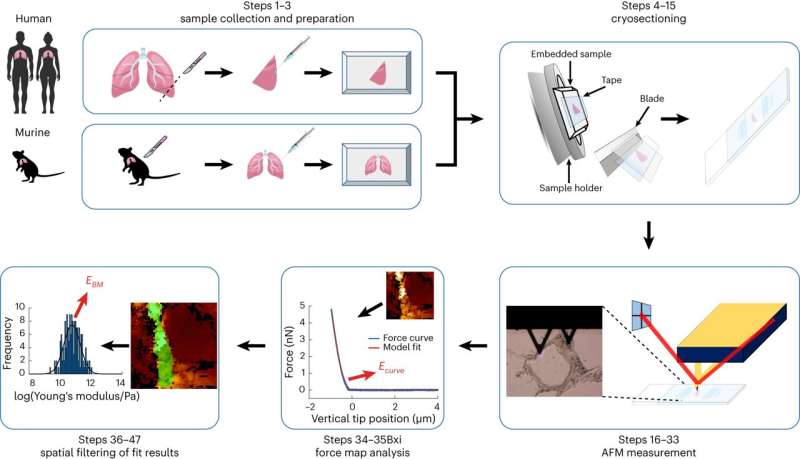This article has been reviewed according to Science X's editorial process and policies. Editors have highlighted the following attributes while ensuring the content's credibility:
fact-checked
trusted source
proofread
New analytical method provides first step toward early diagnosis of metastasis

Metastases are largely responsible for the death rate of patients with solid cancers; the prognosis of cancer patients reduces significantly if metastases are diagnosed. Until now there has been no procedure available to reliably predict the probability of future metastases.
A team of scientists from Denmark and Germany led by Junior-Professor Dr. Raphael Reuten from the Medical Faculty at the University of Freiburg and Professor Hauke Clausen-Schaumann from Munich University of Applied Sciences (HM) has now taken the first step toward early diagnosis of metastasis formation: they have developed a user-friendly method for analyzing the basement membrane in the human body—because its mechanical properties are a crucial factor during the metastatic process. The results have been published in Nature Protocols.
Softer basement membranes are harder to overcome
"We're convinced that the publication of this method in the form of a detailed protocol will make it possible to get closer to an early diagnosis of metastasis formation," says Reuten. Using the protocol, scientists around the world will be able to identify if various individuals possess distinct basement membrane mechanics, and whether these are associated with metastasis formation.
The basement membrane is a structure of the extracellular matrix—the protein mass outside cells—that surrounds all blood vessels, many organs and also tumors.
In the past it was assumed that this structure was only a barrier that cancer cells have to overcome with the help of their own mechanisms. However, in a paper from 2021, Reuten and Clausen-Schaumann were able to show that the mechanical properties of the basement membrane is itself a decisive factor influencing the metastasis of cancer cells and therefore also the prognosis of cancer patients: the softer the basement membrane, the fewer cancer cells overcome this barrier—resulting in a decrease in metastases—and extended survival.
Analysis by semi-automated software
Together with the University Medical Center Freiburg's obstetrics and gynecology clinic and the pathology department at Copenhagen's Rigshospitalet, the scientists have now published an analysis tool in the form of a detailed and user-friendly step-by-step guide, showing how to determine the mechanical properties of the basement membrane in human lungs.
The team has also made semi-automated software for the analysis of measurement data and identification of the basement membrane available to the scientific community. This software will in future become even more powerful with Artificial Intelligence.
"Once there are more comprehensive data, fully-automated recognition of the basement membrane using machine learning will be implemented," says the first-author of the study, Bastian Hartmann from the Munich University of Applied Sciences (HM).
The basement membrane has a thickness of only 100 to 400 nanometers (roughly one ten-thousandth of a millimeter). "Localizing it exactly in the tissue, measuring its mechanical properties and discerning this precisely from that of the surrounding tissue was an exceptional challenge," says biophysicist Hauke Clausen-Schaumann.
"We were able to solve this with a combination of optical microscopy and atomic force microscopy." The new protocol now expands this procedure to include the basement membrane of human lungs making it feasible for non-experienced users.
Additional findings for cancer research
The scientists anticipate important findings for cancer research to be obtained with their method. This is because although tumors reshape many structures in the body to make them meet their needs, independently of such cancer-related changes the individual mechanical properties of the basement membrane have a crucial influence on the process of metastasis.
Therefore, it might be possible, Reuten theorizes, that certain mechanisms of the basement membrane make some people in principle more vulnerable to develop metastasis.
More information: Bastian Hartmann et al, Profiling native pulmonary basement membrane stiffness using atomic force microscopy, Nature Protocols (2024). DOI: 10.1038/s41596-024-00955-7



















